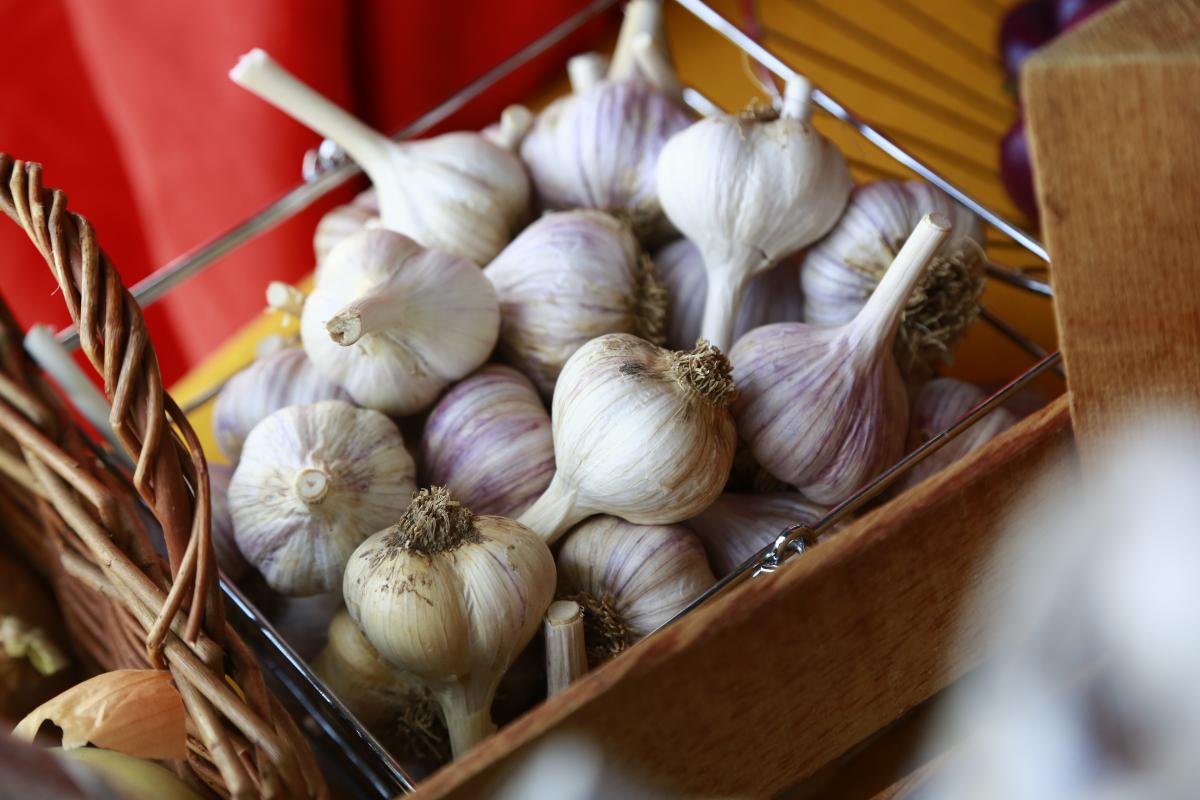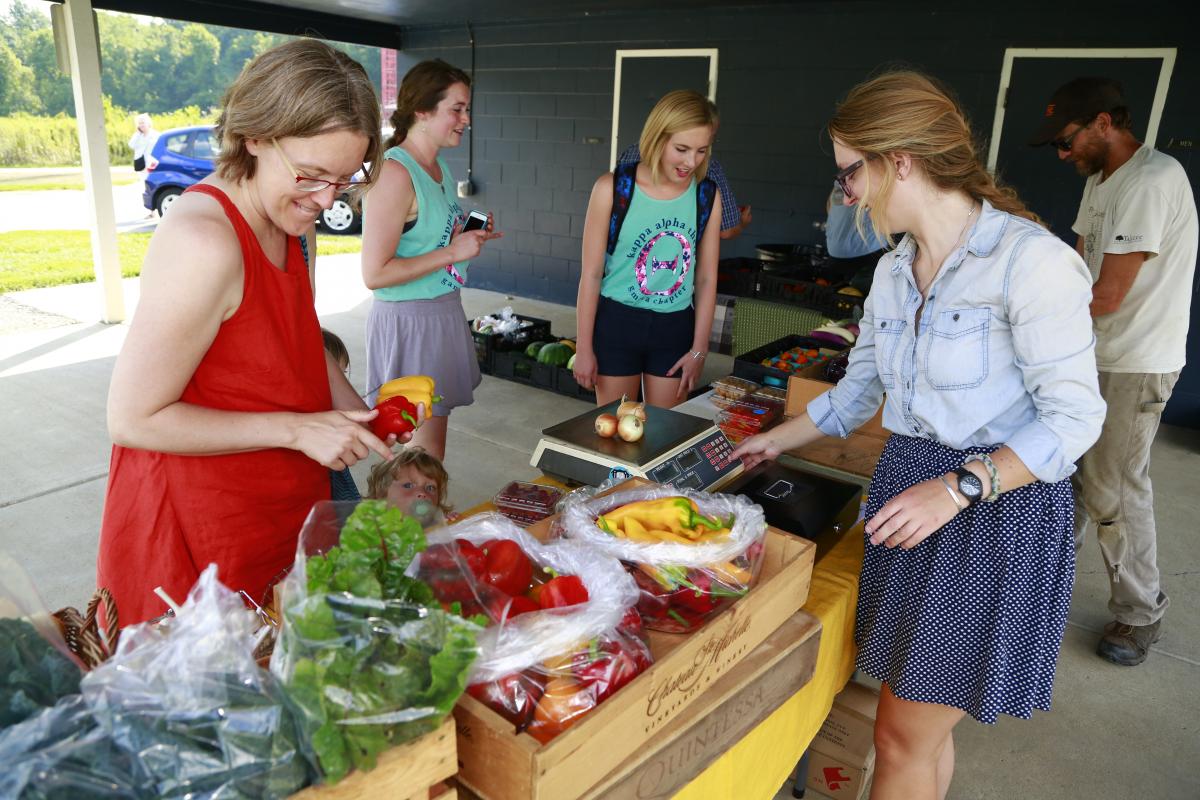This story is part of a mini-series exploring The Farm at Butler, its methods, and its mission. Part six of six.
2021 UPDATE: All products (except plant starts) are now sold directly to Butler’s campus dining services provider, Bon Appetit. Bon Appetit purchases more than 40 percent of its food from local farmers and producers to feed our campus community. The Farm aims to engage students in a host of ways to think about agriculture, food systems, ecology ,and sustainability; many students work on the farm through various programs, visit the farm with their classes, do research on the farm, complete a PWB class at the farm, or interact with the farm in other ways. Bon Appetit is the best partner to bring the literal product of the farm into their daily lives.
The Farm at Butler grows nearly 10,000 pounds of food each year, all by hand. There’s watermelon, always-popular strawberries, bok choy, electric fence-protected squash, peppermint, hazelnuts, and, after The Farm’s staff finally won an ongoing battle with the nearby finches, swiss chard. Just to name a few.
Some of the food goes to weekly grab-and-go boxes for subscribers to The Farm’s Community-Supported Agriculture program (if you stick out the two-year waiting list). Some goes directly to the Thursday-afternoon Farm Stand. Another portion, sold to Butler Dining, ends up on plates around campus.
But explore Indianapolis enough, and you will find The Farm on a table near you. That’s because local restaurants, such as Public Greens, Cafe Patachou, Napolese, and Good Earth Natural Foods, rely on The Farm to keep their meals as fresh as possible.

Sourcing Indy’s Food Scene
Tyler Herald doesn’t cook tomatoes in the winter.
In July, the Patachou, Inc. Executive Chef won’t put butternut squash on the menu. Instead, Herald reads the seasons—or, the texts he gets from local farmers—to build meals from the freshest ingredients he can find.
When it comes to the original Napolese, Patachou’s artisanal pizza joint at 49th and Pennsylvania, it’s tough to get more local than a few blocks away from Butler. Herald still remembers the day about 10 years ago, shortly after the restaurant’s launch, when two Butler students walked in and asked if he wanted to buy some vegetables. Ever since, he’s bought as much produce as The Farm at Butler is ready to sell.
Just last week, Herald bought nine pounds of parsnips to roast up for a seasonal side dish. He’s simmered soups with The Farm’s sunchokes, topped off cakes with sliced strawberries, and sprinkled basil on his pizzas. He buys local foods in pursuit of the quality that comes with using produce at its peak, so he’s able to let the fruits and veggies speak for themselves.
“There’s not a ton of manipulation,” he says. “I think you want to let the ingredients be the star.”
Except for during the few deep-winter months when Indiana can only grow pine trees and nearby farmers have emptied their storage, Herald shops local for nearly all the food he cooks. The closer the farm, the less time it takes vegetables to get from vine to kitchen, and the longer they can spend ripening out in the sun. Avoiding cross-country trips also means steering clear of preservatives or other chemicals that often reduce the food’s overall quality.
But Herald understands why buying local might not appeal to everyone. It takes time, planning, and usually a little extra cash.
“It’s really easy to pick up the phone at 11:00 PM, call a produce company, and magically have all your stuff the next morning,” he says. “Instead, a farmer texts me on Sunday and I have to tell them what I will need on Wednesday. That’s harder: You have to plan because the farmer still needs to harvest the food, wash it, package it, and drive it to you. But for me, it’s worth it to have the best stuff.”
Herald was attending culinary school in Portland, Oregon, when he first noticed restaurants highlighting local farms on their menus. He thought it was the coolest thing to know exactly where his carrots came from. And after interning with a farm-to-table place in Chicago, he knew he wanted to join the rising movement of supporting local growers.
Sometimes, that calls for a bit of extra creativity—like when customers want a hot bowl of chili on a cold winter day. Ingredients for the standard tomato-based dish only grow here in the summer, so Herald’s cold-weather version counts on rutabaga and squash.
Luckily for Indianapolis chili lovers, he can find both at a farm that’s right down the road.

Subscribe to Local Produce
For Courtney Rousseau, opening a box of fruits and vegetables from The Farm’s Community-Supported Agriculture (CSA) program is like opening up a season of hard work.
“You’re opening a box of love,” says the Butler Career Advisor.
Rousseau first joined the CSA wait list in 2013 after she noticed during her after-work Farm Stand visits that some guests were picking up pre-assembled boxes instead of buying individual items. About two years later—after moving to Oregon for a few months and ultimately coming back home to Butler—she received an email saying it was her turn to join the program.
That’s the typical wait time for The Farm’s CSA, which is capped at about 20 members each year. The program, a bit like a food subscription service, allows members to pay up-front for a weekly share of produce from July through October.
Farm Manager Tim Dorsey creates the boxes each week based on what’s available. He always includes some familiar items like cucumbers and tomatoes, but a big appeal for most members is trying out things they don’t typically eat.
“I hadn’t eaten beets in 30 years until this summer,” Rousseau says. “Now that’s my new favorite thing.”
Inside each box, Dorsey includes a note with updates on what’s been going on around The Farm that week. Maybe he finished planting the garlic, or maybe the rain made it hard to keep up with the mowing. The note also lists everything inside the box, with descriptions for the more obscure items (like those turnips that are best eaten sliced into salads), and tidbits about how they were grown (like how that rain kept your cabbage healthy without the need for irrigation). And in case you aren’t sure what to do with your new box of veggies, a weekly recipe provides one tasty option—perhaps in a swiss chard galette or a batch of kale jalapeño hummus.
Rousseau sometimes follows the recipes, but she often prefers to create something of her own. She likes making nontraditional summer salads, for example, like one filled with green beans, rainbow beets, and cherry tomatoes. She might sauté some eggplant to eat over oven-dried tomatoes, chop radishes and carrots into a coleslaw, or pickle up some cucumbers with help from her son.
“Cooking, for me, is a way to spend time with my husband and my son instead of on a screen,” she says. “It lets you know where all of your energy is going to come from. What can I create this week that is going to sustain me?”
Cooking is just one part of the farm experience for Rousseau. It’s not even all about the food. She visits The Farm every chance she gets, taking time to cherish the walk and take in what’s happening around her. Over the summer, she even schedules walk-and-talk meetings at The Farm so she can help introduce people to the space.
“It just goes back to following the seasons and following nature, and being in tune with where you are,” she says. “It’s very grounding to go down to that space, to watch the seasons change, to see the leaves turn colors throughout The Farm Stand season, and to see everything bloom and flourish in the middle of the summer.”
If you are interested in joining The Farm at Butler’s CSA program, sign up for the wait list here. The program lasts 21 weeks, and boxes typically feed two people. Cost: $420, with half due by April 15 and the other half due at pickup on the first Thursday of June.

Discover Something New
“Will you be open again next week?” the woman asks, handing her vegetable haul to the intern who’s running today’s Farm Stand.
Yes, she’s glad to learn: The Farm is open every Thursday afternoon from June through October. As she pays and walks back toward the Central Canal—where a sign along the path had pointed her down to The Farm Stand—a regular customer bikes up the road to take her place. He glances over the tables covered with bell peppers, beets, jalapeños, and kale before filling his slim backpack with deep green cucumbers and the last of the tomatoes.
The Farm Stand features a different selection of produce each week, depending on what’s most in-season. Whether you want to add a Thursday farm visit to your weekly routine or just pick up a few veggies for a new recipe, you can follow The Farm on Instagram or Twitter for the latest updates on what’s available.

Butler’s Backyard Garden
For Butler Dining’s chefs, produce from The Farm makes food taste more alive.
While Bon Appétit can rarely buy enough Farm at Butler produce to build a meal that feeds a campus, Executive Chef Brandon Canfield takes all he can get to sprinkle into menus across the café. He might not be able to buy the 100 pounds of carrots he needs to prepare one side dish for a station in the Marketplace at Atherton Union, but purchasing five pounds of a dozen different vegetables lets him add finishing touches to spice up his dishes.

“When you get things from a quarter-mile away, there’s this inherent quality—there’s this life that you get when you eat vegetables straight from the garden,” Canfield says.
The Farm was a natural partner for Bon Appétit, the national food management company that took over Butler Dining last spring. Bon Appétit cooks all its food from scratch, and at least 20 percent of ingredients come from within 150 miles of campus.
At Butler, chefs source food from about 10 different local farmers and artisans. In addition to The Farm, these partners include Fischer Farms, Local Farms Harvest, Dandy Breeze Creamery, and Julian Coffee Roasters. Whenever meals feature local ingredients, daily menus highlight where the products came from.
Beans and tomatoes from The Farm often serve as accents, and Canfield sometimes crafts meals around what’s available right on campus. Mid-sized, light green peppers from Butler’s backyard? Ideal for stuffing with whole grains and campus-grown greens. Just add a scoop of beans from The Farm, and you’ve got a whole lunch that traveled less than 10 minutes to your plate.
READ MORE:
Part 1: Getting To The Root of It: How Butler’s One-Acre Farm Has Evolved In a Decade
Part 2: Farming Full-Time: How Tim Dorsey Discovered the World Through Agriculture
Part 3: A Crash Course on Nature-Focused, Hands-In-The-Dirt Growing
Part 4: Sustainability on the Syllabus
Part 5: A Model for Urban Farming in Indianapolis
Part 6: So, Where Does All The Food Go?
Explore the full Farm at Butler mini-series here
Media Contact:
Katie Grieze
News Content Manager
kgrieze@butler.edu
260-307-3403 (cell)
Community Partnerships
Through collaboration and strong partnerships, Butler Beyond will unleash the potential of our brilliant faculty and students on the complex issues facing our community. Support for this pillar will expand Butler’s reach and roots in the Indianapolis community and beyond by cultivating deeper integration with local organizations and businesses, increasing experiential learning opportunities for students, nurturing new ventures, and more. Learn more, make a gift, and read other stories like this one at beyond.butler.edu.


